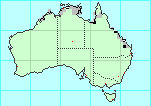
Common Name:
Delete this section if there is no common name.
Identification:
Length: large.
Coloring: brown.
Note any distinguishing features.
both sexes are alate and capable of flight.
volant; male and female mesopterous.
-
Body length: male 73-74 mm, female 100-110 mm.
-
Coloration: Brown, with longitudinal black median line along length of
dorsal surface.
-
Head: Slightly longer than wide; black longitudinal stripe and other
darker bands. Antennae long, easily exceeding length of forelegs.
-
Thorax: Pronotum equal in length with head. Mesonotum 3.5 - 4 × length
of pronotum, with a number of tubercles present. All segments with black
longitudinal median line.
-
Abdomen: Long and slender, with longitudinal black line. End of anal
segment almost truncate in female, but triangular in male. Female
operculum slender, tapered at tip, reaching slightly in excess of end
of 9th abdominal segment; male subgenital plate almost reaching end of
9th segment. Cerci extremely long two pronged structure.
-
Wings: Forewings short, margin truncate. Hind wings long, whitish with
dark brown veins. Forewings and preanal part of hind wings brown.
-
Legs: Long and slender, smooth.
 Note parental placement of eggs.
Note appearance of eggs.
Note any common variations.
Note parental placement of eggs.
Note appearance of eggs.
Note any common variations.
Egg: Capsule dark brown, with grey micropylar plate running from the
anterior capsule rim to almost full length of capsule surface; rather
broadened in center, then tapered to a rounded base. Operculum a shallow
dome. Capsule length 2 mm, width 1.5 mm, height 1.2 mm.
Habitat:
Note if the species arborial or terrestrial.
Canopy, mid, under, etc.
Note typical vegetation, e.g.
tropical rainforest, temperate rainforest,
grasslands,
alpine, etc.
Similar Species:
Rearing Notes:
Note if this species has ever been reared.
Note any suggestions for successful rearing.
For a stick insect with body length 105mm, to keep 2 adult females,
you need a cage at least 500mm high, 250mm deep and 250mm wide.
 Range:
Range:
N coastal, N Gulf, NE coastal, Murray-Darling basin, NT, QLD.
Status:
It is not known if this species is endangered,
as there is insufficient sighting history.
References
-
Balderson, J., Rentz,
D.C.F. and Roach, A.M.E. (1998).
in
Houston, W.K.K. & Wells, A. (1998) (eds)
Zoological Catalogue of Australia.
Vol. 23.
Archaeognatha, Zygentoma, Blattodea, Isoptera, Mantodea, Dermaptera,
Phasmatodea, Embioptera, Zoraptera.
Melbourne: CSIRO Publishing, Australia (ISBN 0643 06035 9).
pp. 347 - 376.
-
Brock, P.D. and Lowe, L.M. (1998).
A Study of Stick-insects (Phasmida) from Kakadu National Park,
Northern Territory, Australia.
J. Orthoptera Research, 7: 71-76
-
Clark, J.T. (1976).
The eggs of stick insects (Phasmida): a review with
descriptions of the eggs of eleven species.
Syst. Ent. 1: 95-105.
-
John, B., Rentz, D.C.F. & Contreras, N. (1987).
Extensive chromosome variation in the stick insect genus Sipyloidea
Brunner von Wattenwyl (Phylliidae: Necrosciinae) within Australia, and
descriptions of three new species.
Invertebrate Taxonomy, 1: 603-630
-
Key, K.H.L. (1970).
Phasmatodea (Stick-insects). pp. 394-404 in CSIRO (ed.) The
Insects of Australia. A textbook for students and research workers.
Melbourne: Melbourne University Press, Vol. 1, 1st Edn.
-
Vickery, V.R. (1983).
Catalogue of Australian stick insects (Phasmida,
Phasmatodea, Phasmatoptera, or Cheleutoptera). CSIRO
Australian Division of Entomology Technical Paper, No. 20, 15 pp.
- Search Google for
Sipyloidea filiformis,
or search Google Scholar for
Sipyloidea filiformis.
Copyright © 2000-2003
Peter Miller
This page was last changed 20-Sep-2006.
|

|

|
 Note parental placement of eggs.
Note appearance of eggs.
Note any common variations.
Note parental placement of eggs.
Note appearance of eggs.
Note any common variations.

 Note parental placement of eggs.
Note appearance of eggs.
Note any common variations.
Note parental placement of eggs.
Note appearance of eggs.
Note any common variations.
 Range:
Range: 
